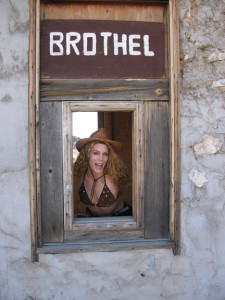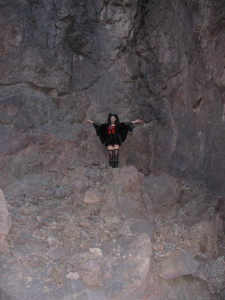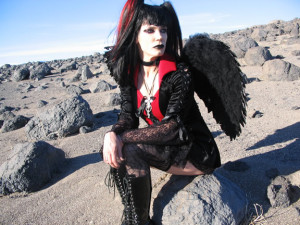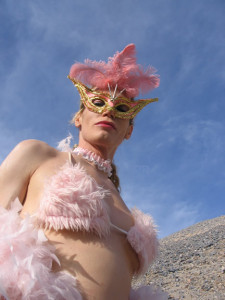A groundwater map in the 1992 report “Ground Water at Yucca Mountain: How High Can It Rise?” by the Commission on Geosciences, Environment and Resources, confirms that groundwater goo from Yucca Mountain would flow into the heart of Death Valley at Furnace Creek. This is the site of the area’s largest oasis, park headquarters, camp grounds for hundreds of travelers, and the ancestral center of the Timbisha Shoshone homeland.
Too Hot to Handle
The closest I’ve come to Yucca Mountain was when I was in company of Darla, a kindly cowgirl along for the ride. We made our way to the ghost town of Rhyolite in Nevada just a few miles down the road from a giant “low-level” nuclear waste dump. It was operated by U.S. Ecology from 1962 to 1992 outside the town of Beatty on a plain that connects with Death Valley’s eastern border.
The Maryland-based Nuclear Information and Resource Service reports that the dump, 105 northwest of Las Vegas, had detections of “tritium at depths of up to 357 feet below ground and carbon-14 at depths of up to 112 feet below ground in a 1994 study. In 1998, the [U.S. Geologic Service] indicated that a 1997 test found even higher concentrations of these radionuclides in the same area.”
NIRS says confirmed reports show that workers took contaminated materials and tools offsite. In 1979, Beatty temporarily shut down the dump because of waste packaging and transportation concerns. Additionally, the U.S. Geologic Survey found radioactive waste containers buried in the arid sands outside the perimeter of the site.
“What are you doing with that little clicking box, City Boy?” Darla asked me in 2008 as I surveyed the dump area with a high tech Geiger counter that has proven useful in numerous investigations. “If you’re looking for something hot, you might find it at the bordello in Rhyolite and not here at this dump.”
Off to Rhyolite. I had a few silver dollars that were burning a hole in my pocket.
After a lively Western-themed afternoon in the ruins, we decided on taking Titus Canyon on our way back into Death Valley. The 26-mile one-way route begins in the Silver State and ends in the Golden State, dropping down a treacherous dirt road one vertical mile before emerging onto the valley floor. The canyon is stunning, but the white knuckler ride had me sweating bullets.
Darla was cool as a cowgirl. “Well, City Boy, if you drive off the edge, at least we had that little shootout back there in Rhyolite,” she said with a grin. “If you ride down this canyon half as good as you did back there, we’ll stay in the saddle good as gold.”
101 Ways to Die
It’s not all fun and dames in Death Valley. The place got its name from one of the pioneers headed west as part of the Gold Rush of 1849. Though only one person in the group actually perished, upon climbing the Panamints and leaving the valley, a man looked back and said, “Goodbye Death Valley” and the name stuck. This has always struck me as odd, as the Panamint Valley isn’t exactly a verdant utopia. Maybe he just hadn’t looked over the top yet.
It would have taken a lot of moxie to follow in the ‘49ers’ footsteps and I am honored to know a true blood relative of those hardy heroes. Runkle Canyon Radiation Ranger “Toxic Terry” Matheny is in fact the descendant of a Jayhawker, a group of ‘49ers that also survived the tough trek to the Golden State. That may help explain his tenacity in fighting KB Home over building 461 homes in Runkle Canyon on land that may be contaminated from the nearby Santa Susana Field Laboratory.
Death Valley is definitely dangerous, for a variety of reasons like summer temperatures that often reach over 120 degrees, unsafe abandoned mineshafts, rattlesnakes, treacherous mountain passes, and its sheer size (1.5 times the area of Delaware) making it easy to stray far from help. And forget cell phones, they don’t work.
On our first visit, Denise Anne said she wanted to go to one of the ranger programs at the visitor center. I resisted. After all, we came to get away from people, and what could some ranger tell us that we couldn’t read about or discover on our own?
“Come on,” she insisted. “We have to go. The talk is called ‘101 Ways to Die in Death Valley.’”
Wanting to stay on her dark side, I obliged and sure wasn’t disappointed. We learned that the number one cause of death in the valley is single-car roll over. Without trees and buildings to help drivers assess their speed, folks can get mesmerized by the expanses and lose control of their vehicles.
The story of the full gasoline tanker losing its breaks down the incline from Beatty to Furnace Creek had an explosive and tragic ending.
“Told you,” Denise Anne said, hitting my leg. “I feel for that poor fellow, though.”
Heat stroke is next on the list of ways to make the Death Valley list. Apparently people don’t realize how important it is to hydrate before hiking, and by the time they are in danger they may be too delirious to realize they have water, and it might be too late to help anyway.
We heard a particularly gruesome story about a young man who tried to hike across the salt flats in the summertime. Like many of the valley’s victims, he was found with plenty of water in his backpack.
The ranger said they initially had troubling identifying this poor soul, as his concerned relatives had described him as Caucasian, but when they found his body he had roasted to a deep mahogany. The corpse was the size of a suitcase.
Another fascinating thing we learned is that “DVDs” – Death Valley Dead in campground slang – are often found nude, not necessarily because they were trying to cool down but because they hallucinate that they are wading in water and try to “swim” to safety. Grim indeed.
There is water in Death Valley’s underground springs, but its lack of surface water and less than 2 inches of rain per year make it the driest place in North America. Last year, Xanterra Parks & Resorts put all the sunshine to good use by installing one of the largest solar energy systems in the United States, with 5,740 solar panels that cover five acres, to help power the park’s resort and other facilities. The National Park Service awarded the new solar facility its 2008 Environmental Achievement Award.
There is a viewing platform over this sea of solar panels surrounded by palm trees in the lush oasis that is Furnace Creek. Denise Anne and I were impressed by the brilliance of the field of suns, literally. I suggested that she could do a sun girl and name her Deity.
“That’s a hot idea,” she smiled sinking her teeth into the picnic spread we had brought. “You will worship me.”
The park’s colors inspire worship as the heavenly 2009 “Living Death Valley” video shows. Without vegetation, splashes of pink, purple, green and blue minerals color the rocks, especially around Desolation Canyon and Artists Drive. Other canyons such as Mosaic, Titus, or Falls Canyon contain walls of sheer marble and granite. Walking through their multi-layered narrows is like walking through time, giving one a distinct perspective on how truly short our lives are.
Wild, Wild Life
Despite Death Valley’s harsh environment, the park is home to diverse wildlife and plants. Big horn sheep and ibex roam in the mountains, while kit fox, jackrabbits, and roadrunners roam below. On this trip, we also witnessed bats, a tarantula, and the clear impression of a sidewinder snake. These rattlesnakes are venomous pit vipers. Perfect for Halloween.
The raven is by far our favorite desert creature – they mate for life. These highly intelligent birds rule in Death Valley, and they know it. They greet us each morning when we stay at Stovepipe Wells village, claim their space on the railing, and go about their business which often involves grooming their partner but a few feet away.
Some of Death Valley’s wildlife is not found anywhere else. I came upon one such strange creature by Salt Creek south of Stovepipe Wells. This is where the rare Death Valley pupfish have survived since Lake Manly, nearly 100 miles long and 600 feet deep, dried up at the end of the last ice age.
Desert Rose caught me by surprise in a canyon close to the creek. She was a statuesque being, adorned in a pink fur riding outfit with elaborate masks and headdresses that make her look like a desert goddess. She looked like she needed a good trot on the tundra.
Pulling up, she looked at me longingly. Desert Rose doesn’t speak, but who needs words when pacing the badlands of this fanciful land? I knew what she wanted; the Racetrack Playa called out to her from over the mountains.
The Racetrack is at the end of 28 miles of bad road and Desert Rose hasn’t been there yet. She is chomping at the bit to get a chance to gallop across the mysterious playa where stones move across the surface carving channels hundreds of yards long.
The mystery of Racetrack’s moving stones seems to have been solved but that hasn’t dampened Desert Rose’s high spirits. She wants to race across the playa. I’m betting she comes in first.
I won’t be coming at all, though, if I don’t secure us a Road Warrior-type vehicle to get out to the Racetrack. The roads are treacherous. That’s par for the course in Death Valley.
Heart of Darkness
Our first day in the valley greeted us with a dust storm that lashed the land with 60 mile per hour winds as Darkness and I navigated our way south. Thousand foot-high walls of sand blew across the basin blotting out the blue skies above. Tumbleweeds and dust devils blew across Highway 190 as Darkness and I made our way through the Devil’s Cornfield.
As we descended below sea level to visit our favorite haunts, the dust storm cleared a bit.
We walked through a blazing white canyon covered in fantastic carpets of salt crystals sparkling under a clearing sky. Next, we strolled through Darkness’ Rock Garden, a surreal expanse of volcanic boulders that somehow landed ages ago next to the salt flats. We then drove down to Mormon Point at the southern end of the massive salt plain where the salt is the thickest at over 9,000 feet deep. This is where, like a bat, the winged Goth goddess clings to the cliff’s side.
Returning north, Darkness and I descended from the Dúath of Darkness and made our way onto the salt.
“Life as we know it is coming to an end,” Darkness said gazing far across the shattered salt. “We must make decisions about how we spend our days.”
Normally I would shun such morbidity, but I desperately wanted a taste of her wind-whipped world.
“Whadaya doin’ tonight?” I asked suggestively. “I could help you lighten up.”
Darkness turned swiftly and stared into my soul.
“Do not disparage my words! I would that it were not so, but the wretched writing is on the wall.”
I started to resign myself to her doom when she continued, “Do not despair. This most astonishing and miraculous land will survive, and our love is eternal. With this knowledge we shall battle on.”
She moved in closer and with a sinister smile added, “Let’s give ‘em Hell.”













Recent Comments